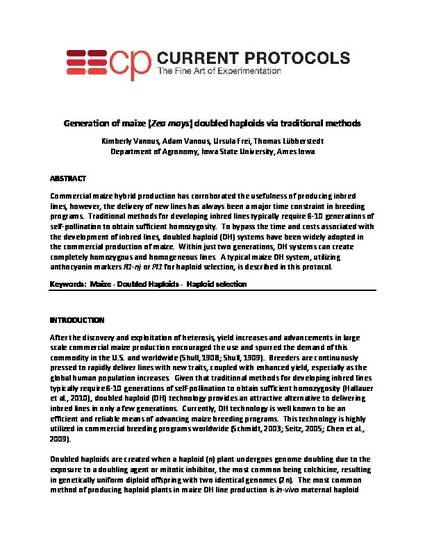
Article
Generation of Maize (Zea mays) Doubled Haploids via Traditional Methods
Current Protocols in Plant Biology
Document Type
Article
Disciplines
Publication Version
Accepted Manuscript
Publication Date
6-8-2017
DOI
10.1002/cppb.20050
Abstract
Commercial maize hybrid production has corroborated the usefulness of producing inbred lines; however, the delivery of new lines has always been a major time constraint in breeding programs. Traditional methods for developing inbred lines typically require 6 to 10 generations of self-pollination to obtain sufficient homozygosity. To bypass the time and costs associated with the development of inbred lines, doubled haploid (DH) systems have been widely adopted in the commercial production of maize. Within just two generations, DH systems can create completely homozygous and homogeneous lines. A typical maize DH system, utilizing anthocyanin markers R1-nj or Pl1 for haploid selection, is described in this protocol.
Copyright Owner
John Wiley & Sons, Inc.
Copyright Date
2017
Language
en
File Format
application/pdf
Citation Information
Kimberly Vanous, Adam Vanous, Ursula Frei and Thomas Lubberstedt. "Generation of Maize (Zea mays) Doubled Haploids via Traditional Methods" Current Protocols in Plant Biology (2017) p. 147 - 157 Available at: http://works.bepress.com/thomas-lubberstedt/50/

This is an accepted manuscript of an article published as Vanous, Kimberly, Adam Vanous, Ursula K. Frei, and Thomas Lübberstedt. "Generation of Maize (Zea mays) Doubled Haploids via Traditional Methods." Current Protocols in Plant Biology: 147-157. doi:10.1002/cppb.20050. Posted with permission.